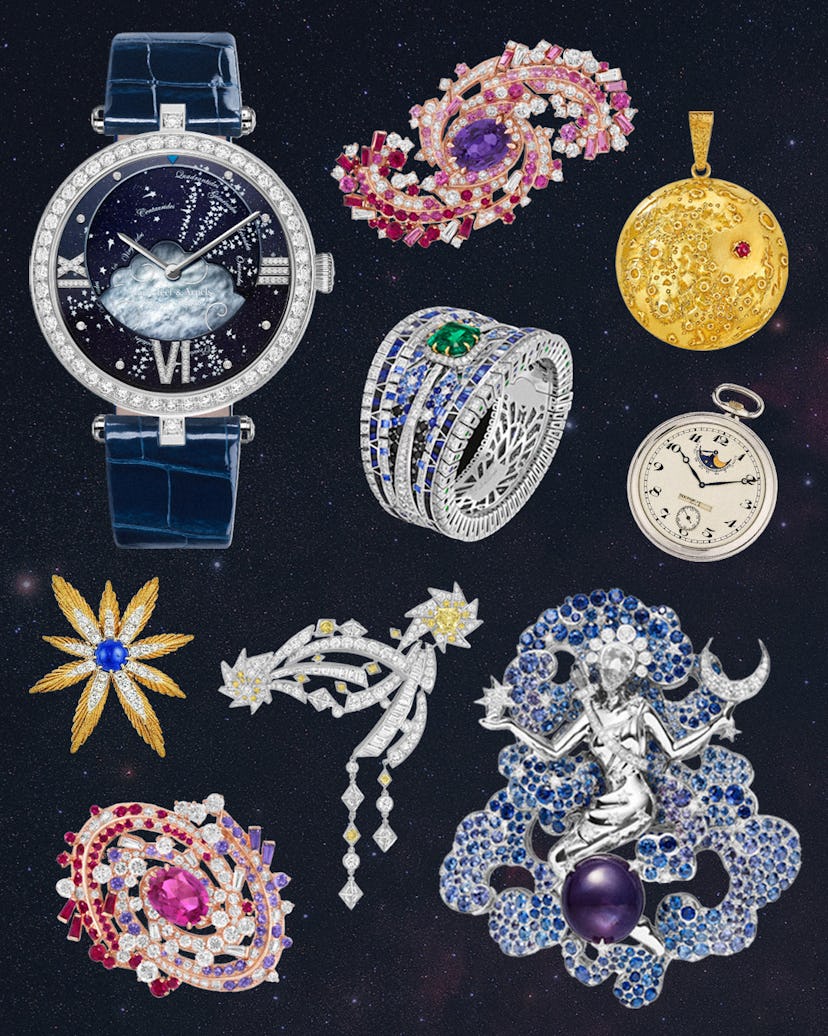A long display case in the American Museum of Natural History’s special exhibition, Cosmic Splendor, illustrates the astronomical concept of stellar evolution, the process by which stars age, changing size and color over their lifespans of millions to billions of years. It’s a fairly typical topic for the renowned New York science institution, which houses such specimens as a 15.5-ton meteorite and a 4.3 billion-year-old zircon crystal. But the objects seen here are more than extraordinary rocks and minerals: they’re Van Cleef & Arpels jewelry.
Specifically, they’re pieces from the French maison’s 2021 Sous les Étoiles high jewelry collection, on view starting April 11. The models of different star types include a blue supergiant ring set with a large sapphire that takes cues from one of the most massive and luminous stars in the night sky, plus a planetary nebula clip featuring a central tourmaline surrounded by concentric rings of spessartine garnets, turquoise, and lapis lazuli. (The latter represents the glowing shell of ionized gas and dust ejected by a dying sun-like star.) There’s also a black hole bracelet representing the collapsed remnant of a massive star from which not even light can escape, with sparkling emeralds, sapphires, black spinels, and diamonds encircling its void.
Jewelry fans who visit the exhibition will get a lesson in Astro 101. According to the museum’s senior vice president for exhibition, Lauri Halderman, enticing new audiences was exactly the point. “If you wanted to know more, you could go from here to the Hayden Planetarium at the Rose Center for Earth and Space, or you could just step outside into the Hall of Gems and Minerals,” Halderman says. The museum previously worked with Van Cleef & Arpels last year on an exhibition about green gemstones.
While jewelry and astronomy might not seem like natural fellow travelers, the wonders of the universe have in fact inspired the Parisian jeweler back to its founding on Place Vendôme in the early twentieth century. Co-curated by patrimony and exhibitions director of Van Cleef & Arpels, Alexandrine Maviel-Sonet; and assistant curator, Department of Earth and Planetary Sciences, Kate Kiseeva, Cosmic Spendor celebrates that rich scientific legacy. “We have cosmic pieces from the ’20s, ’30s, ’40s, all the decades up to the present,” Maviel-Sonet says. “The first, a star-shaped pearl and diamond brooch, is from 1907.”
Archival jewelry and timepieces are organized in cases by the type of astronomical object they represent, from our solar system—the moon, planets, and the sun—to those beyond, including stars and galaxies. The lunar case features a 1929 platinum moon phase pocket watch and a 2024 Lady Jour Nuit watch with a gold sun and diamond-set moon beside a textured gold 1969 moon pendant and clip. Similar to keepsakes given to each of the three Apollo 11 astronauts to commemorate the moon landing, it resembles the lunar surface, replete with a ruby cabochon to mark the point of disembarkation.
The moon pendant.
Double Galaxies Clips.
Although the exhibition is open until January 2026, those who visit before April 20 will also have the chance to see a Planétarium automaton, a jewel-encrusted version of a mechanical solar system model used to illustrate planetary orbits known to astronomers as an orrery. Accompanied by an original melody by panflutist Michel Tirabosco, this waltz of the planets centers around a brilliant sun fashioned from yellow sapphires, spessartite garnets, and diamonds set on 500 gold stems. But whenever visitors drop in, they can enjoy the show’s out-of-this-world soundtrack that features David Bowie’s “Space Oddity” and Frank Sinatra’s “Fly Me to the Moon,” intercut with real audio from NASA space missions.
